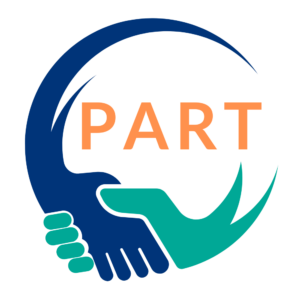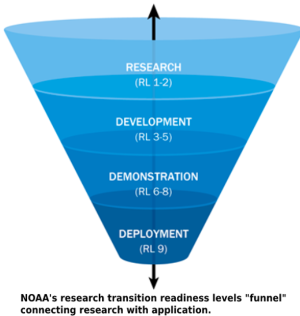The NOAA Weather Program Office (WPO) is proud to announce the launch of REACH—the Research Explorer for Articles, Code, and Hosted Data—a thrilling new tool set to transform open science! …


The Portfolio Analysis & Research Transitions (PART) Program streamlines research transitions by providing tailored support, office-wide project monitoring, and data-driven portfolio insights. As a liaison with NWS OSTI, we foster coordination, address challenges, and drive decision-making while promoting open science to ensure WPO-funded research is accessible and beneficial for practitioners and the public.

We support WPO Programs with communicating NOAA’s transition process, managing the transition plan process, and developing transition policies for the office.
We maintain the Project Directory infrastructure, manage NRDD updates, ensure PARR compliance, and track Open Science metrics to support accurate reporting and project monitoring strategic decision-making.

We act as the primary liaison with NWS OSTI, support WPO Programs in coordinating Points of Contact, and assist with resolving challenges in the transition process.

We provide portfolio evaluations, consultation on analyses, gap and trend assessments, and support in communicating research value to enhance strategic decision-making.
The transfer of research and development (R&D) to an operation, application, commercial product or service, or other uses is called a transition. Transitioning research requires coordination, planning, and sharing of knowledge and other research outputs from one group to another and vice versa. Successful transitions increase the return of U.S. taxpayer investments in NOAA’s R&D, support U.S. economic development, and contribute to accomplishing NOAA’s mission.

WPO works to ensure research outputs are useful, usable, and eventually put into practice. Engaging potential end users ahead of writing a proposal for funding can enhance the relevance and feasibility of proposed research. Partnering with end users can provide particularly valuable insights. This collaboration ensures that research outputs are not only theoretically sound but also practically applicable and beneficial to practitioners.

Readiness Levels (RLs) are how NOAA tracks the progression of transitionable R&D projects along a spectrum of Basic Research (RL1) through operational transition (RL9). NOAA uses RLs to characterize the status of R&D relative to its readiness to be used operationally or in other societal applications. Projects reaching RL4 (successful testing in experimental environment) or beyond are required to complete a transition plan.
Collaborative Funding Opportunities, particularly the annual Notice of Funding Opportunity (NOFO), are the primary mechanism for supporting transitionable R&D projects. WPO continually engages its partners, especially in OAR, NWS, and academia, to better inform research priorities. Input from operational centers and external partners allows WPO to regularly identify and assess current science gaps and develop funding priorities to address them.
When preparing your proposal, keep in mind that WPO uses RLs to assess project maturity—not to evaluate the accuracy of a proposal’s RL designation. We also recognize that research and development takes time, so projects are not expected to progress through all RLs within a single two- or three-year funding period.
RL 1: Basic research, experimental or theoretical work undertaken primarily to acquire new knowledge of the underlying foundations of phenomena and observable facts, without any particular application or use in view. Basic research can be oriented or directed towards some broad fields of general interest, with the explicit goal of a range of future applications (OECD, 2015).
RL 2: Applied research, original investigation undertaken in order to acquire new knowledge. It is, however, directed primarily towards a specific, practical aim or objective. Applied research is undertaken either to determine possible uses for the findings of basic research, or to determine new methods or ways of achieving specific and predetermined objectives (OECD, 2015).
RL 3: Proof-of-concept for system, process, product, service, or tool; this can be considered an early phase of experimental development; feasibility studies may be included.
RL 4: Successful evaluation of system, subsystem, process, product, service, or tool in a laboratory or other experimental environment; this can be considered an intermediate phase of development.
RL 5: Successful evaluation of system, subsystem process, product, service, or tool in relevant environment through testing and prototyping; this can be considered the final stage of development before demonstration begins.
RL 6: Demonstration of a prototype system, subsystem, process, product, service, or tool in relevant or test environment (potential demonstrated).
RL 7: Prototype system, process, product, service or tool demonstrated in an operational or other relevant environment (functionality demonstrated in near-real world environment; subsystem components fully integrated into system).
RL 8: Finalized system, process, product, service or tool tested, and shown to operate or function as expected within the user’s environment; user training and documentation completed; operator or user approval given.
RL 9: System, process, product, service or tool deployed and used routinely.
A Transition Plan is a document that represents an agreement between clearly identified researchers and potential recipients, organizations, or other users of the product resulting from the transition of an R&D output.
Transition Plans include general information about the project and a proposed process for how it can most efficiently be integrated into operations or other applications. Early (and often) coordination during a project allows for researchers, developers, and operators to identify both the potentials for success and possible limitations of both the new technologies/ideas and the existing operational framework, and strategize a connection between the two.
Have end user write a letter of support
PIs/PMs should revisit TP once a year to update progress as needed. This helps leadership with budget/resource planning.
A transition team usually consists of the R&D team including PIs and Federal POCs, end users, and line office leadership including lab directors and the leadership of the adopting line office

We conduct comprehensive evaluations of WPO’s R&D portfolio, providing office-wide or division-specific insights that support informed decision-making.
We offer expert guidance on best practices for conducting portfolio analyses, interpreting findings, and addressing other data analysis needs.
We use portfolio analysis findings and insights to identify research gaps, evaluate trends over time, and recommend priorities for future funding and strategic initiatives.
We provide relevant data to help programs effectively communicate the value and impact of their research, highlighting its societal benefits.
The PART Program is committed to advancing open science principles within the Weather Program Office. Open science promotes transparency, accessibility, and collaboration by ensuring WPO-funded research outputs – such as publications, dataset, and code – are freely available to practitioners, policymakers, scientists, and the public.
This aligns with NOAA’s Public Access to Research Results (PARR) policy, which mandates free and immediate public access to federally funded research, and enhances the societal impact of our research. Below, we provide key resources to help Principal Investigators (PIs), grantees, and partners comply with open science requirements and maximize the value of their work.
This guide walks PIs through open science requirements at every stage of their WPO award: from award start, through publishing and presenting, to closeout and post-award activities. It includes step-by-step instructions for compliance, submission processes, best practices, and useful links.
Standardized language for acknowledging WPO funding in research outputs (e.g., publications, datasets, and code) ensures proper credit and compliance with PARR. Use this language in acknowledgments sections, metadata, or README files.
This publication/dataset was funded by the NOAA Weather Program Office (https://ror.org/01q70bz83) under award NAXXOAR459XXXX.
The Research Explorer for Articles, Code, & Hosted Data (REACH) is WPO’s open science tool that provides a centralized, searchable platform for WPO-funded research outputs, including journal articles, code, datasets, and tools. REACH connects practitioners, scientists, policymakers, and the public to these resources, accelerating knowledge sharing and supporting evidence-based decision-making.

The NOAA Weather Program Office (WPO) is proud to announce the launch of REACH—the Research Explorer for Articles, Code, and Hosted Data—a thrilling new tool set to transform open science! …
The Ocean Prediction Center (OPC) rolled out its experimental Week 2 Marine Hazards Outlook in mid-March, providing guidance about the chance of certain wave heights and wind speeds at longer…
WPO’s Research Transitions team is now the Portfolio Analysis and Research Transitions (PART) Program as it takes a more integrated approach to transitioning research into practice. PART’s primary role in…
A new virtual reality simulation shows people why coastal evacuation orders are so important during storms. “Weather the Storm” was funded by the NOAA’s Weather Program Office and created through…
NOAA’s newest hurricane model, the Hurricane Analysis and Forecast System (HAFS), was instrumental in providing forecasters with accurate predictions of Hurricane Helene and Hurricane Milton during the 2024 hurricane season,…
Atmospheric rivers, often described as a “firehose of moisture,” can bring intense rainfall to the West Coast, leading to intense inland flooding. How people perceive and respond to these risks…
Portfolio Analysis and Research Transitions (PART) Program Manager
Portfolio Analysis and Transition (PART) Lead
Open Science and Transition Specialist